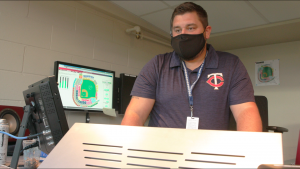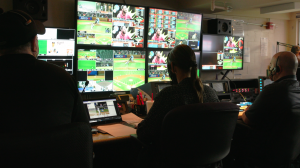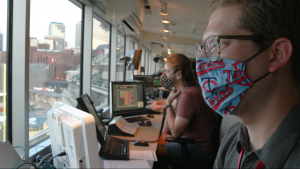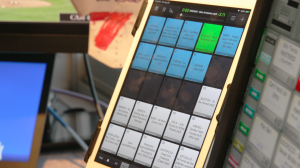At the Ballpark: Minnesota Twins Infuse Personal Touches in Player-Centric Videoboard Production
With fans at home, players are the star of the show
Story Highlights
Although Major League Baseball is continuing with a 60-game regular season, the pulse of what makes professional baseball exciting remains at home. In the midst of the ongoing COVID-19 pandemic, 30 in-venue departments are forging ahead with operations inside empty stadiums. SVG’s At the Ballpark series takes you behind the control-room door and examines what it’s like to produce a fan-less venue experience in 2020.
Baseball is a team sport in every essence of the phrase, drawing on the strengths and skills of every player on the 25-man roster. As the saying goes, there’ s no “i” in team, but there is most certainly an “i” in Twins. With no fans to entertain, the in-venue team is putting each player in the spotlight with specific music playlists, hype videos, graphics, and more.
MORE AT THE BALLPARK INTERVIEWS:
- DodgersVision Leverages New Audio System, Blend of Traditional and Contemporary Content
- DBTV Productions Uses Chase Field as Testing Ground for New In-Venue Approach
- Tampa Bay Rays Integrate Social-Media Content, Fan Videos on Tropicana Field Videoboards
- Cincinnati Reds Use Unique Season To Learn New HDR Videoboard
- Detroit Tigers Focus on Fan Engagement, Rely on Scrimmages for In-Venue Strategy
- Mariners Productions Keeps Players, Onsite Staff on Schedule With In-Venue Routine at T-Mobile Park
- New York Mets’ In-Venue Show Entertains Players On-Field
“Since we’re not adhering to fans this season, we’re just adhering to the players,” says Sam Henschen, director, game day experience, Minnesota Twins. “We’re not just doing stuff to do stuff. Our hope is that on the videoboards, it’s information or entertainment that the players might enjoy listening to or glance up at.”
Center of Attention: Player Requests Dictate Sights, Sounds at Target Field

Whether it’s crowd noise or music, audio has played a huge role for the Minnesota Twins this season.
Major League Baseball, in general, is becoming more of a player’s league, with an exciting youth movement currently under way. Players are more likely than in previous seasons to express themselves in the form of bat flips, body language/gestures, and custom-made spikes or other accessories. Target Field has become home to high-profile, exuberant players, like Miguel Sanó, Eddie Rosario, and José Berríos. In addition, with players with nicknames like Nelson “Boomstick” Cruz and Josh “Bringer of Rain” Donaldson, it’s only right to cater videoboard content to this packed roster.
“We wanted to make sure that the players felt as normal as possible,” says Henschen. “We know that the players aren’t necessarily watching the videoboard since they’re warming up and getting ready to play, but we’re putting stuff up in the background in case they do peek up there. We’ve built a hype video for each of our players, and, when they come up to bat or go on the mound, we have a minute video that can play right before the start of an inning.”
Rather than sit and wait for the season to begin, the Twins in-venue team is proactive with their time. In a jam-packed season with consecutive games, losing attention to detail can be common throughout the grind of an 81-game home schedule. Prior to the beginning of this year’s campaign, the content team had more time to define and fix any mistakes.
“One benefit of being away from the ballpark is that all of our graphics that we’ve created over the last six months are the nicest-looking that we’ve ever had,” says Henschen. “Despite none of our fans’ seeing these graphics, we had the additional production time to put some of the finesse and finishing touches on things.”
Along with videoboard elements, the players are calling the shots when it comes to music. Without an in-person audience comprising a variety of ages, the playlist is filled with songs that are bit more contemporary.
“We’ve developed this philosophy where we’re playing songs between innings that the players would like more than 18- to 65-year-olds in the crowd [would],” he says. “We’ve also been incorporating a lot of music between pitches as well; before, we used to maybe have organ music play or nothing at all. They want games to be treated almost like an NBA game, where there’s music constantly because it would help them as hitters.”
Open Dialogue: Constant Feedback Helps Refine Audio Quality
Aside from visuals and music, fabricated crowd noise is also being tailored to the players’ tastes. Conversations are held with both in-venue and on-field teams to come up with a perfect solution.
“Our strategy has changed from Game 1 until now with our players,” says Henschen. “We had to turn down the audio to make the crowd noise softer, make the crowd noise louder, or the cheering wasn’t loud enough. We just listened to [the players] and said, ‘Hey, hit us with what you want. We’re only adhering to you guys. If it’s really loud in the upper deck, we don’t care since we know that, on the field, it’s exactly the volume that you want.’ If fans were in the stadium, we’d obviously have to play the balancing act.”
Fake crowd sounds have become engrained in the fabric of this 2020 season. Since it’s a completely new concept, it has become a job done well through concentration and timeliness. With each passing home game, the audio team has learned when to hit or not hit certain buttons on the MLB-sanctioned iPad.
“We’re trying to figure out the [right] balance,” Henschen explains. “If a guy strikes out and the cheer happens three seconds too late, we’ve decided that we’re just not going to do that in the future. If you just don’t hit the button soon enough or the button misfires, don’t press it later, because we’re trying to be as authentic as possible. Sometimes, nothing is better than something if you’re late to the gun.”
Scoreboard Watching: 60-Game Season Influences Run of Show
Getting caught scoreboard watching is a baseball superstition that comes with bad luck or misfortune, but, in this shortened season, it has become more of a likely occurrence. Because Henschen and his staff understand the importance of out-of-town scores, they’re doing whatever they can to keep the team informed on where they are in the race toward the postseason.
“We want to keep an eye on our out-of-town scoreboard,” he says. “With the truncated season, each game is worth 2.7 games more compared to our [usual] regular season. The games are much more important, especially as we get into late August, September. Other games are going to be watched very closely as we get ready to get into postseason play.”
Between the lines, friends don’t necessarily exist when they wear an opposing team’s jersey, but, nowadays, in the offseason, players either hang out or train with members of other teams. Since there is a ton of camaraderie in the league, it’s only natural to want to know how your buddy is doing in San Diego or what the best and brightest in the game are up to. The in-venue crew is keeping the Twins up-to-date on those highlights as well.
“We’ve touched base with our players about seeing replays of big home runs or other things that are going on around the league,” he adds. “Who has hit the longest home run? Did Aaron Judge hit another 470-ft. bomb, or did Orlando Arcia make a great diving play? They’re up-to-date on all of that stuff with their peers on other teams.”
Curtain Call: Notable Names of Twins’ In-Venue Team
Despite the obstacles and challenges that have popped up this year, the Twins are atop the American League Central and are in the mix as one of the best overall teams in the league. While the players notch win after win, Henschen and company will continue to do a phenomenal job for baseball fans in the Twin Cities.
“There’s definitely a couple of people I want to give a shout out to,” he says. “[Video Manager] Jim Diehl has been fantastic with figuring out some of the technical issues in the control room in terms of these unique setups. [Scoreboard Operations Manager] Jeremy Loosbrock has done a great job with building all of our hype videos. Audio Engineers Steve Peterson and Trevor Chick have never watched baseball games as closely as they do now with crowd noise. They’re used to running the board, but they’ve taken that responsibility, owned it, and made it pristine.”
With seven games remaining in a recent 10-game road trip, the Twins won’t be back in Minnesota near the tail end of the month, when they face the Chicago White Sox at Target Field on Monday, Aug. 21 at 8:10 p.m. ET.



